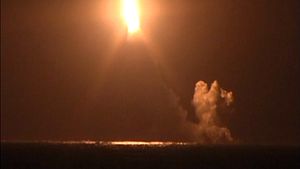After repeated delays, the Borei-class (aka Dolgorukiy-class), Project 955 fourth generation nuclear-powered ballistic missile submarine (SSBN) Vladimir Monomakh successfully test fired two Bulava (RSM-56) ballistic missiles from a submerged position in the White Sea off the northwest coast of Russia, RT reports.
According to a press release by the Russian Defense Ministry, the two missiles successfully hit targets in the Kamchatka region in Russia’s Far East on November 15:
Salvo firing from a submerged position was made in accordance with the plan of combat training. The parameters trajectory of two ICBM “Bulava” worked normally. As confirmed by objective monitoring, the missile warheads successfully arrived at the Kura test site in Kamchatka.
However, some source claim that the test launch was a failure with one missile self-destructing during its boost phase and the other missing its targets. The Bulava submarine-launched ballistic missile, a variant of the land-based Topol-M SS-27, is one of the most expensive Russian weapons programs and intended to be the cornerstone of the sea-based component of Russia’s nuclear triad.
Since 2004, the missile has been tested 24 times with varying degrees of success. (The last four tests, conducted in the period of September 2014 to November 2015, were all successful.)
The Bulava is specifically designed to evade Western ballistic missile defense shields. It can engage in rapid evasive post-launch maneuvers, deploy decoys, and launch other countermeasures to avoid interception. Each missile carries ten hypersonic, independently maneuverable warheads, yielding 100-150 kilotons apiece. The Bulava’s range is estimated at around 8300 kilometers.
A Borei-class SSBN can carry between 12 to 16 Bulava (RSM-56) ballistic missiles for a total of up to 160 warheads per submarine. The Vladimir Monomakh, the sub from which the missiles were launched on November 15, was commissioned in December 2014 and is currently undergoing sea and weapon trials.
As I reported before, the arrival of the Borei-class SSBN Vladimir Monomakh in the Pacific Ocean has been postponed to 2016 due to outstanding trials (some sources indicate that the delay has been, in fact, due to a failure of the Russian defense industry to deliver a full set of Bulava ICBMs).
Designed by Rubin Marine Equipment Design Bureau and built by Northern Machine Building Enterprise (Sevmash shipyard), the Borei-class (“North Wind”) is intended to replace the aging Project 941 Typhoon-class and Project 667 BDRM Delta IV-class submarines. As I noted in another article (See: “Russia’s Deadliest Sub Is Heading to the Pacific”):
All in all, the Russian Navy plans to build eight SSBNs of this class (with an option to construct two more) by 2020. The next vessel in the class, the Knyaz Vladimir, is designated as a Project 955A Borei II. It could field four more additional missile tubes (bringing the total number of missiles potentially up to 20) and is currently under construction.
Four Borei-class SSBNs are slated to join Russia’s Pacific Fleet over the next few years.
































